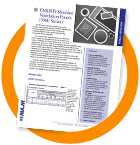We’ve Been Getting A Lot Of Questions Recently About Solutions For Navigating Galvanic Corrosion In EMI Shielding Design.
And we’ll provide answers and design resources for EMI and RFI professionals in this post.
Here’s what we’re going to cover:
- What is galvanic corrosion in the context of EMI shielding design?
- What are the concerns surrounding galvanic coupling in EMI and RFI shielding design?
- Where can you go for EMI/RFI design resources and more information?
You asked for solutions, and we’re delivering.
So let’s get started with the basics.
Galvanic Corrosion—The Underlying Mechanism
Galvanic corrosion occurs when electron transfer, or oxidation, takes place between dissimilar metals in a corrosive environment.
So there are two processes involved: oxidation and corrosion.
In a Galvanic couple, the metal that’s more prone to natural oxidation corrodes at an accelerated rate, while the less oxidizable metal corrodes more slowly. A simple galvanic series chart, which lists metals based on their oxidation tendencies, helps predict the corrosion potential when dissimilar metals are coupled.
Courtesy of Interference Technology
These charts are helpful, but they’re not absolute.
In EMI shielding design and assembly, where metals like aluminum are paired with dissimilar metals less prone to oxidation, the risk of galvanic corrosion becomes a significant concern.
Galvanic corrosion can cause significant issues in EMI shielding projects, particularly when metal components, like vents, frames, flanges, access panels, doors, etc., are integrated into the design.
Let’s take aluminum, for example. Aluminum, known for its active nature and tendency to form a natural oxide layer, is often used in EMI shielding. However, when in contact with dissimilar metals, especially in corrosive environments, aluminum’s susceptibility to corrosion increases.
The bottom line?
The effective coupling of dissimilar metals, which is inevitable in component and material specifications, can present significant challenges to EMI/RFI engineers and designers.
Challenges In Material Selection For EMI Shielding
Typical conductive fillers in EMI shielding, like elastomer gaskets, are often infused with metal or metal-coated particles. While silver or nickel-coated particles are preferred for their high conductivity, their interaction with aluminum in corrosive conditions, including high humidity and maritime environments, can significantly increase the potential for corrosion.
Nickel or nickel-coated graphite, for example, which is often used as a gasket material, can also cause increased aluminum corrosion.
Understanding the behavior of core-shell particles, like silver or nickel-coated composites, is also essential. That discussion is beyond the scope of this post, but suffice to say that these particles can take on the galvanic characteristics of the core material, resulting in an increased potential for galvanic corrosion.
So what’s the answer?
Innovations In Conductive Fillers—Resources From MAJR Products
MAJR Products offers an innovative resource to address many of the challenges presented by conductive fillers and gaskets for EMI shielding projects.
Abbreviated Galvanic Compatibility Chart—Courtesy Of MAJR Products
In the world of EMI/RFI shielding design, selecting materials that are galvanically compatible is essential to reduce corrosion in the short term and over time.
MAJR Products’ Galvanic Compatibility Interactive Chart serves as a valuable resource for designers and engineers of all stripes. Our goal? Making the selection and specification of optimal material combinations simpler and more intuitive.
Developed from a traditional full Galvanic Compatibility chart, the interactive version makes it easier for the EMI/RFI designer to get a quick visual of the voltage potential across dissimilar metals in a variety of environments.
Our commitment to innovation and practical solutions is intended to support our clients in every aspect of EMI and RFI design/build. And that includes galvanic coupling material selection.
So Where Can You Go For More Information?
That’s the easy part. You’re already in the right place.
MAJR Products is an internationally recognized leader in designing and manufacturing the highest quality shielded vent panels, windows, waveguides, gaskets, and more.
You can download the GC chart for free here.
Or maybe you still have questions or additional EMI/RFI design challenges you’d like to discuss with an expert.
Wherever you’re at in your EMI/RFI design-build journey, you can get in touch with us online or simply click the “Request a Quote” button on the upper right-hand side of any of our web pages.
For more information, you can also call us anytime at (877) 625-6033.
*PRODUCT PERFORMANCE: Galvanic compatibility claims and or recommendations to reduce corrosion as identified in MAJR Products’ literature, whether typed, graphed, or in table form are based and derived from military/industry standards. Published values may not represent actual galvanic performance in all applications; variables such as temperature, humidity, vibration, and other environmental conditions play a large role in galvanic compatibility of metals. MAJR Products does not guarantee the galvanic compatibility or protection of metal surfaces, the values seen in its literature are for reference only and to be used as a guide. Customer testing in an intended environment with dissimilar metals for a specific application is strongly recommended.


